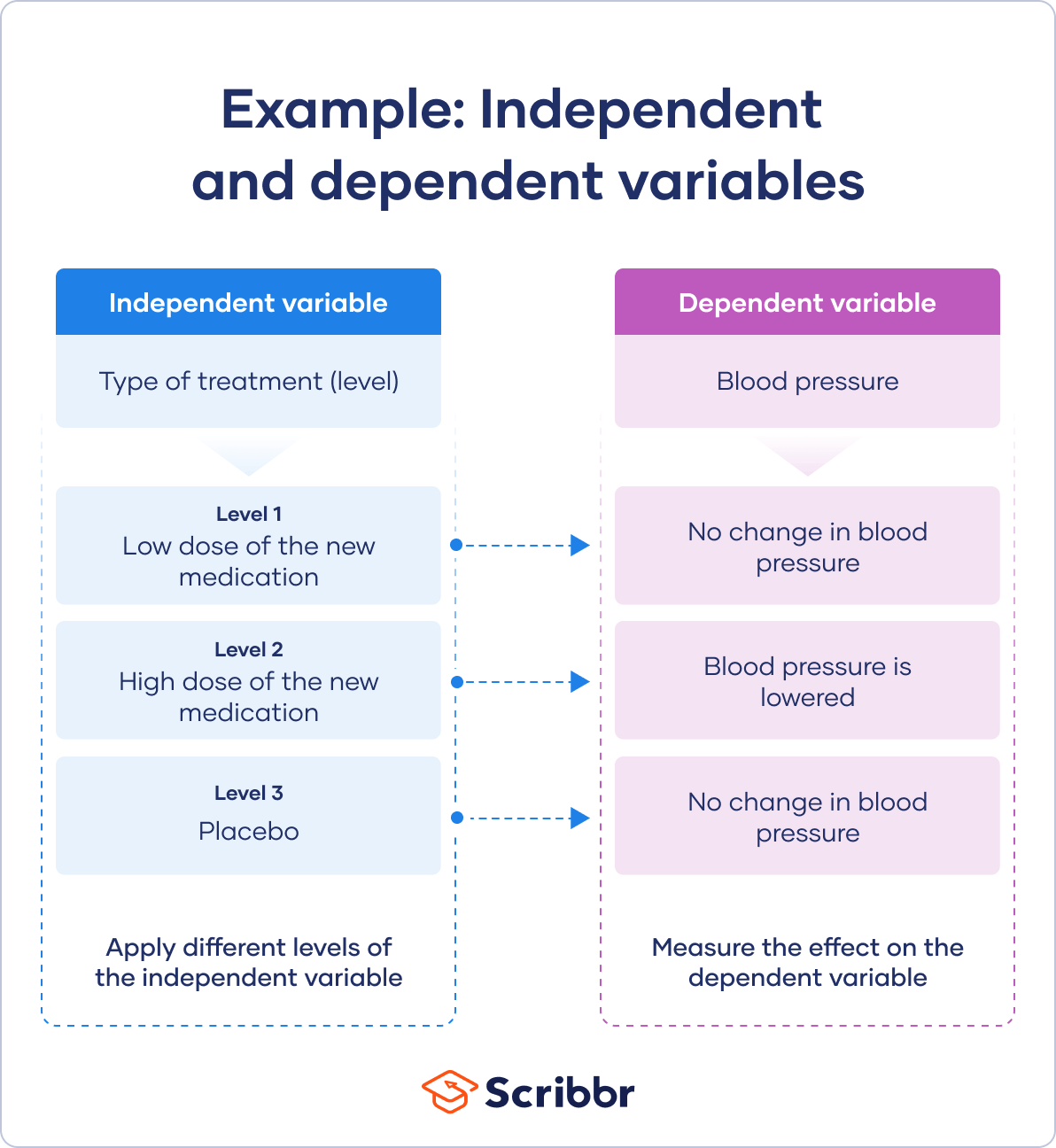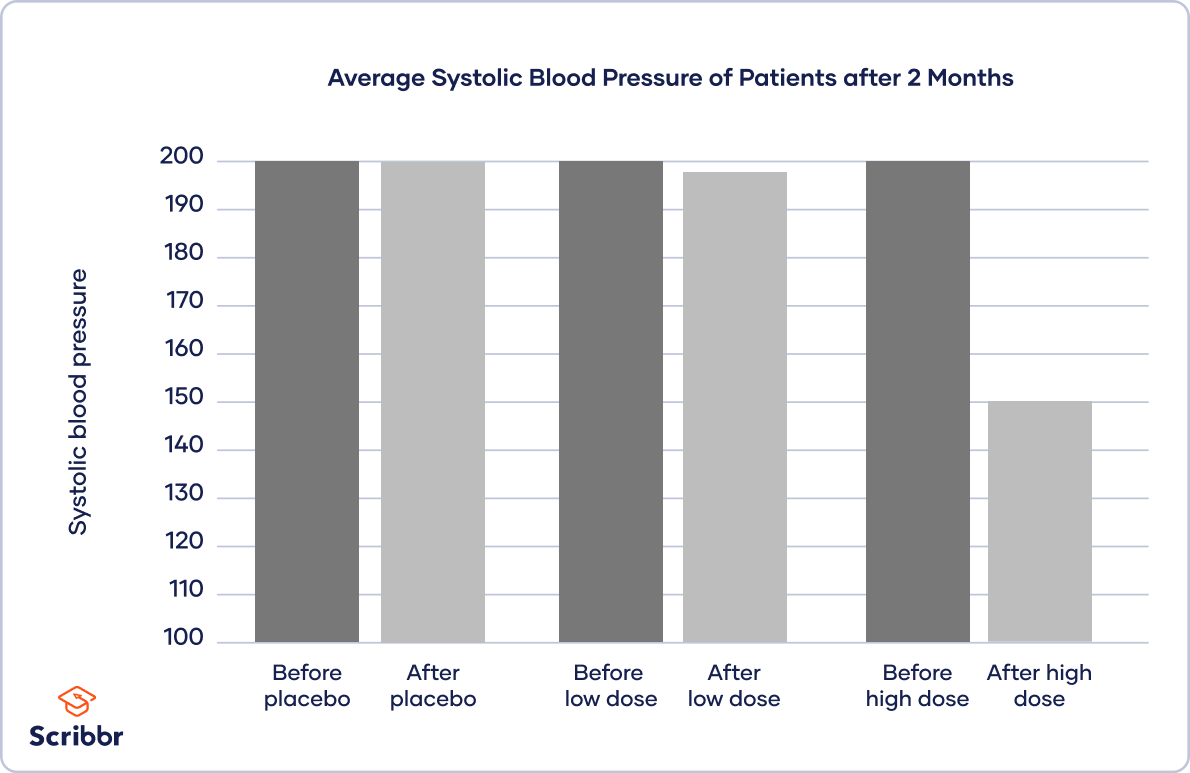How To Find Independent And Dependent Variables
Independent vs. Dependent Variables | Definition & Examples
In research, variables are any characteristics that tin take on different values, such as height, age, temperature, or test scores.
Researchers often dispense or measure independent and dependent variables in studies to examination cause-and-consequence relationships.
- The independent variable is the cause. Its value is independent of other variables in your study.
- The dependent variable is the consequence. Its value depends on changes in the independent variable.
Your independent variable is the temperature of the room. Y'all vary the room temperature by making it cooler for half the participants, and warmer for the other one-half.
Your dependent variable is math test scores. You lot measure the math skills of all participants using a standardized test and check whether they differ based on room temperature.
What is an independent variable?
An independent variable is the variable you manipulate or vary in an experimental study to explore its effects. It's called "independent" because it's non influenced past any other variables in the study.
Independent variables are also called:
- Explanatory variables (they explain an effect or effect)
- Predictor variables (they tin can be used to predict the value of a dependent variable)
- Correct-hand-side variables (they appear on the right-hand side of a regression equation).
These terms are especially used in statistics, where yous estimate the extent to which an independent variable alter can explain or predict changes in the dependent variable.
Types of contained variables
In that location are two chief types of independent variables.
- Experimental contained variables tin can be directly manipulated by researchers.
- Field of study variables cannot exist manipulated past researchers, but they can be used to group research subjects categorically.
Experimental variables
In experiments, you manipulate independent variables directly to see how they impact your dependent variable. The independent variable is ordinarily applied at different levels to see how the outcomes differ.
Yous can utilise just 2 levels in order to find out if an contained variable has an effect at all.
You tin can likewise utilize multiple levels to find out how the independent variable affects the dependent variable.
You lot have 3 independent variable levels, and each grouping gets a dissimilar level of handling.
Y'all randomly assign your patients to 1 of the three groups:
- A low-dose experimental grouping
- A high-dose experimental grouping
- A placebo grouping

A true experiment requires you to randomly assign dissimilar levels of an independent variable to your participants.
Random consignment helps you lot control participant characteristics, so that they don't touch on your experimental results. This helps you lot to have confidence that your dependent variable results come up solely from the independent variable manipulation.
Subject area variables
Discipline variables are characteristics that vary across participants, and they can't be manipulated by researchers. For example, gender identity, ethnicity, race, income, and education are all important subject variables that social researchers treat every bit contained variables.
It's not possible to randomly assign these to participants, since these are characteristics of already existing groups. Instead, yous can create a research pattern where you lot compare the outcomes of groups of participants with characteristics. This is a quasi-experimental design because in that location's no random consignment.
Your independent variable is a subject variable, namely the gender identity of the participants. Y'all take three groups: men, women and other.
Your dependent variable is the brain activity response to hearing babe cries. You record encephalon activity with fMRI scans when participants hear infant cries without their awareness.
After collecting information, you check for statistically significant differences betwixt the groups. Y'all detect some and conclude that gender identity influences brain responses to baby cries.
What is your plagiarism score?
Compare your newspaper with over 60 billion spider web pages and 30 million publications.
- Best plagiarism checker of 2021
- Plagiarism report & percent
- Largest plagiarism database
Scribbr Plagiarism Checker

What is a dependent variable?
A dependent variable is the variable that changes as a issue of the independent variable manipulation. It's the outcome you're interested in measuring, and information technology "depends" on your contained variable.
In statistics, dependent variables are likewise called:
- Response variables (they answer to a change in another variable)
- Outcome variables (they represent the outcome you desire to mensurate)
- Left-paw-side variables (they announced on the left-hand side of a regression equation)
The dependent variable is what you tape after yous've manipulated the independent variable. You apply this measurement data to cheque whether and to what extent your independent variable influences the dependent variable past conducting statistical analyses.
Based on your findings, you tin judge the caste to which your contained variable variation drives changes in your dependent variable. Yous can also predict how much your dependent variable will alter as a result of variation in the independent variable.
Identifying contained vs. dependent variables
Distinguishing between independent and dependent variables can be tricky when designing a circuitous written report or reading an academic newspaper.
A dependent variable from i study can be the contained variable in some other study, and so information technology's important to pay attention to research design.
Here are some tips for identifying each variable type.
Recognizing independent variables
Employ this list of questions to check whether you're dealing with an independent variable:
- Is the variable manipulated, controlled, or used as a subject group method by the researcher?
- Does this variable come up before the other variable in fourth dimension?
- Is the researcher trying to understand whether or how this variable affects another variable?
Recognizing dependent variables
Cheque whether you're dealing with a dependent variable:
- Is this variable measured equally an effect of the report?
- Is this variable dependent on another variable in the report?
- Does this variable go measured but after other variables are altered?
Independent and dependent variables in research
Independent and dependent variables are by and large used in experimental and quasi-experimental enquiry.
Hither are some examples of inquiry questions and respective contained and dependent variables.
| Research question | Independent variable | Dependent variable(s) |
|---|---|---|
| Do tomatoes abound fastest under fluorescent, incandescent, or natural light? |
|
|
| What is the effect of intermittent fasting on blood sugar levels? |
|
|
| Is medical marijuana effective for pain reduction in people with chronic pain? |
|
|
| To what extent does remote working increment job satisfaction? |
|
|
For experimental information, you clarify your results past generating descriptive statistics and visualizing your findings. Then, y'all select an appropriate statistical test to test your hypothesis.
The type of exam is determined by:
- your variable types
- level of measurement
- number of independent variable levels.
You'll often use t tests or ANOVAs to analyze your data and answer your research questions.
Visualizing independent and dependent variables
In quantitative research, it'due south good practice to use charts or graphs to visualize the results of studies. By and large, the contained variable goes on the x-axis (horizontal) and the dependent variable on the y-axis (vertical).
The type of visualization y'all use depends on the variable types in your enquiry questions:
- A bar chart is platonic when you lot have a categorical independent variable.
- A besprinkle plot or line graph is best when your independent and dependent variables are both quantitative.
To inspect your information, yous identify your independent variable of treatment level on the x-centrality and the dependent variable of blood force per unit area on the y-axis.
Y'all plot confined for each treatment group before and after the treatment to show the difference in blood pressure.
Based on your results, y'all note that the placebo and depression-dose groups show lilliputian difference in blood pressure, while the loftier-dose group sees substantial improvements.

Frequently asked questions about independent and dependent variables
- What's the definition of an independent variable?
-
An independent variable is the variable you manipulate, control, or vary in an experimental study to explore its furnishings. It's called "independent" because it's not influenced by any other variables in the study.
Independent variables are also called:
- Explanatory variables (they explain an consequence or outcome)
- Predictor variables (they tin be used to predict the value of a dependent variable)
- Right-mitt-side variables (they appear on the right-hand side of a regression equation).
- What'south the definition of a dependent variable?
-
A dependent variable is what changes as a issue of the independent variable manipulation in experiments. It's what you're interested in measuring, and it "depends" on your independent variable.
In statistics, dependent variables are also called:
- Response variables (they respond to a alter in another variable)
- Outcome variables (they represent the upshot y'all want to measure)
- Left-manus-side variables (they announced on the left-manus side of a regression equation)
- Can I include more than than 1 independent or dependent variable in a study?
-
Yes, but including more ane of either type requires multiple research questions.
For example, if yous are interested in the effect of a diet on health, y'all can employ multiple measures of health: claret carbohydrate, blood pressure, weight, pulse, and many more. Each of these is its own dependent variable with its own inquiry question.
You could also choose to wait at the effect of exercise levels equally well every bit diet, or even the additional effect of the two combined. Each of these is a separate independent variable.
To ensure the internal validity of an experiment, you should only change one independent variable at a time.
Is this article helpful?
You have already voted. Cheers :-) Your vote is saved :-) Processing your vote...
Source: https://www.scribbr.com/methodology/independent-and-dependent-variables/
Posted by: gravescolmilluke.blogspot.com

0 Response to "How To Find Independent And Dependent Variables"
Post a Comment